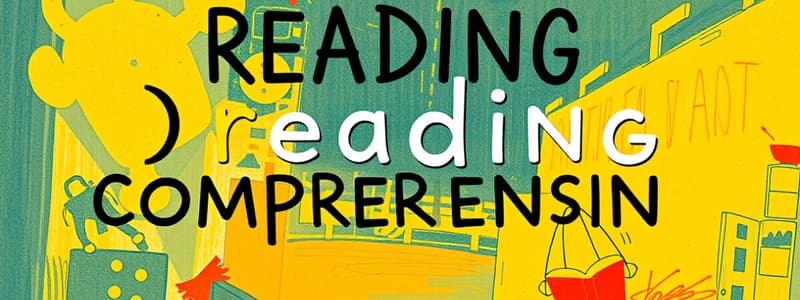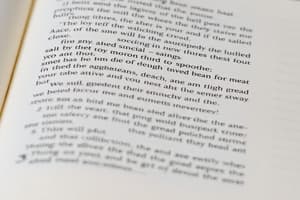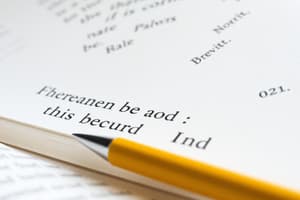Podcast
Questions and Answers
Which component of reading comprehension involves converting written symbols into sounds?
Which component of reading comprehension involves converting written symbols into sounds?
- Vocabulary Knowledge
- Fluency
- Decoding (correct)
- Text Structure
What role does fluency play in reading comprehension?
What role does fluency play in reading comprehension?
- It correlates with better understanding. (correct)
- It ensures accurate pronunciation.
- It helps in predicting text structure.
- It enhances vocabulary acquisition.
What is an essential strategy for improving reading comprehension that involves engaging with the text?
What is an essential strategy for improving reading comprehension that involves engaging with the text?
- Discussion and Collaboration
- Self-Monitoring
- Visualizing
- Active Reading (correct)
How does background knowledge affect reading comprehension?
How does background knowledge affect reading comprehension?
What is the primary function of text structure in reading comprehension?
What is the primary function of text structure in reading comprehension?
Which strategy involves creating mental images to enhance understanding of the text?
Which strategy involves creating mental images to enhance understanding of the text?
What does self-monitoring entail during the reading process?
What does self-monitoring entail during the reading process?
What type of comprehension question requires readers to make inferences based on evidence?
What type of comprehension question requires readers to make inferences based on evidence?
Study Notes
Overview of Reading Comprehension
- The ability to understand, interpret, and analyze written texts.
- Critical for academic success and effective communication.
Key Components of Reading Comprehension
-
Decoding
- Converting written symbols (letters) into sounds.
- Involves phonemic awareness and knowledge of letter-sound relationships.
-
Vocabulary Knowledge
- Understanding the meaning of words and phrases.
- Importance of context clues for word meanings.
-
Fluency
- The ability to read smoothly and accurately.
- Influences comprehension; faster reading often correlates with better understanding.
-
Text Structure
- Awareness of different organizational patterns (e.g., chronological, cause-effect).
- Helps in predicting content and understanding relationships between ideas.
-
Background Knowledge
- Prior knowledge and experiences that inform understanding.
- The greater the background knowledge, the easier it is to comprehend new information.
Strategies for Improving Reading Comprehension
-
Active Reading
- Engage with the text through annotation, highlighting, and note-taking.
- Ask questions and summarize sections after reading.
-
Visualizing
- Create mental images of the content to enhance understanding and retention.
- Use graphic organizers to represent information visually.
-
Inference Making
- Read between the lines to understand implicit meanings.
- Use clues from the text and prior knowledge to draw conclusions.
-
Self-Monitoring
- Assess comprehension while reading; pause to clarify confusing parts.
- Reread or adjust reading speed as needed.
-
Discussion and Collaboration
- Engage in discussions about the text to deepen understanding.
- Share perspectives and insights with peers.
Assessment of Reading Comprehension
-
Types of Questions
- Literal: Focus on facts directly stated in the text.
- Inferential: Require readers to make inferences based on evidence.
- Evaluative: Ask for judgments or opinions about the text.
-
Tools for Assessment
- Standardized tests, comprehension quizzes, and reading logs.
- Informal assessments through teacher observations and discussions.
Common Challenges in Reading Comprehension
- Limited vocabulary leading to misunderstandings.
- Difficulty in connecting ideas or themes across texts.
- Lack of engagement or interest in the material.
Tips for Educators
- Incorporate varied texts to build vocabulary and background knowledge.
- Use scaffolding techniques to support struggling readers.
- Foster a love for reading through discussion, choice, and relevance to students' lives.
Overview of Reading Comprehension
- Understanding, interpreting, and analyzing written texts are crucial for academic achievement and effective communication.
Key Components of Reading Comprehension
- Decoding:
- Involves converting written symbols into sounds, relying on phonemic awareness and letter-sound relationships.
- Vocabulary Knowledge:
- Comprehension improves with a strong understanding of words and phrases, using context clues to discern meanings.
- Fluency:
- Smooth and accurate reading correlates with better comprehension; increased reading speed often enhances understanding.
- Text Structure:
- Recognizing organizational patterns, such as chronological or cause-effect, aids in anticipating content and discerning relationships among ideas.
- Background Knowledge:
- Existing knowledge and experiences facilitate comprehension; richer background knowledge eases the understanding of new information.
Strategies for Improving Reading Comprehension
- Active Reading:
- Techniques include annotating, highlighting, and taking notes. Encouraging questions and summarization after reading enhances engagement.
- Visualizing:
- Forming mental images and utilizing graphic organizers assist in comprehension and retention of the material.
- Inference Making:
- Drawing conclusions based on implicit meanings requires synthesizing text clues with prior knowledge.
- Self-Monitoring:
- Readers should evaluate their understanding during reading, pausing to clarify confusing sections and adjusting their reading speed as necessary.
- Discussion and Collaboration:
- Engaging with peers in discussions deepens understanding and brings diverse perspectives to the text.
Assessment of Reading Comprehension
- Types of Questions:
- Literal questions target facts stated in the text, inferential questions involve making deductions from evidence, while evaluative questions require opinions about the content.
- Tools for Assessment:
- Standardized tests, comprehension quizzes, and reading logs are formal tools. Informal assessments include teacher observations and discussions.
Common Challenges in Reading Comprehension
- Limited vocabulary can lead to misunderstandings of text.
- Difficulty in connecting themes or ideas across different texts can hinder comprehension.
- A lack of interest or engagement in the material reduces motivation to read.
Tips for Educators
- Use a diverse range of texts to enhance vocabulary and background knowledge among students.
- Implement scaffolding techniques to assist struggling readers in navigating texts.
- Create a love for reading by promoting discussions, allowing student choice, and connecting reading material to their lives.
Studying That Suits You
Use AI to generate personalized quizzes and flashcards to suit your learning preferences.
Description
This quiz covers the essential components of reading comprehension, including decoding, vocabulary knowledge, fluency, text structure, and background knowledge. Understanding these key components is vital for enhancing reading skills and achieving academic success.




